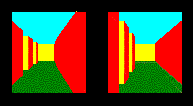I don't program in C, but hopefully this description would be
much simpler than C code.
First, there is a World Map. This is basically an "area" of memory
describing what is in the virtual reality world. Memory is usually
labeled by the number in which it "appears", starting at zero and
going up to a binary number equal to 1024 times how many K
you have. So it's really a line. To make it a square (map) or cube (space),
you need to use YX as the byte number, as explained on the first page.
As long as the world has dimensions that are powers of 2...
(2,4,8,16,32,64,128,256,512,1024,2048,4096,8192...)
the math is simple in calculating lots of things very quickly in the
game. (But it's not required, and if your world was not 8x8 like
the one shown below, you'd use Y*80+X for example to find your
place in memory in an 80x25 world.) In the map below, the upper left
corner is 00 and the lower right is 77 (actually 63 or 3F depending on
how you are counting...octal, decimal, or hex). In binary,111111.
The prime element of YX graphics is SET X,Y,COLOR for a dot;
if you still don't get it, get an Etch-a-Sketch,
call one knob X and the other Y, and play for a while.

To make a random maze in this map, place symbols for Wall
in a square shape on the map, using whatever symbol is convenient.
(W, 1, or in this case, whatever number represents a color.)
Then there are several methods of making the maze, which
usually make mazes with only one path between two places,
unless you want more than one way to go.
One of the simplest and best ways to make a maze is to shuffle
all of the positions that can be "rooms" or have up to 4 ways to
go. (Every other space that is not a "room" is a "hall" and can only
have 2 exits; the corners are "rooms" even though they can only
have 2 exits also.) Select a room and remove the wall symbol from it.
Then continually search the remaining rooms full of wall, and if there
is an open room near that room, remove the wall symbol from it,
and also from the "hall" space between it and the open room. Forget
about the room you just created, and when no rooms are full of wall,
you have a maze. Again, this is not the only way to do this. And a
nicer looking maze can be made using a similar method if you consider
the "hall" spaces as "thin walls" and the rooms as having pebbles in them
until they are visited and one of their walls is broken down to a room
which has no pebble.
Here is the result of making a maze.

This is the same maze visualized another way. (not relevant!)

Look at the red-walled maze in the upper right corner.
The blue dot represents a player, and the arrow represents
which way he is looking. This MAP can be translated into
a "3D" view in perspective:

And for 3D VR goggles, perspective for both eyes could
have been generated... something like this...

Generating perspective:
This game probably started from the foreground and moved outward toward
the center, but it is better to start from the background and move toward
you so that closer objects will naturally and simply cover ones behind them.
This game also used nothing but 4 sided polygons covering a horizon.
ALL LINES THAT GO THE WAY YOU ARE FACING TEND TO
MEET AT THE CENTER. Again, perspective is only important in
stereoscopic displays... volumetric ones don't compute it at all.
(A painting requires it but a sculpture does not.)
The 3D Maze game looked forward a step at a time, and on each step
also looked left and right. If the space was not empty, it would draw a
wall (or other object in some games). The Player had these variables:
Position: X and Y
Direction (vector): XV and YV
example directions:
North: XV=0:YV=-1
South: XV=0:YV=1
West: XV=-1:YV=0
East: XV=1:YV=0
turning procedure:(used also to detect left and right walls)
Turn left: XV2=YV:YV=-XV:XV=XV2
Turn Right: XV2=-YV:YV=XV:XV=XV2
Move forward: X=X+XV:Y=Y+YV
The game would continue looking forward until it hit a wall,
and then the view would be complete.
The first of these 3D maze game's rules were simply to get out
of the maze, which was definitely larger than in this example.
Others sometimes had objects, enemies, hexagonal rooms, or
the possibility of going up and down (the maze itself was 3D).
There are obviously more than 4 directions possible for motion,
using either lookup tables or rotation math.